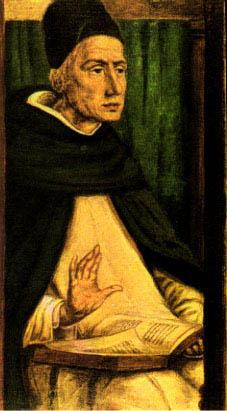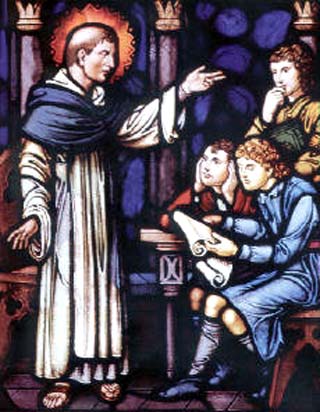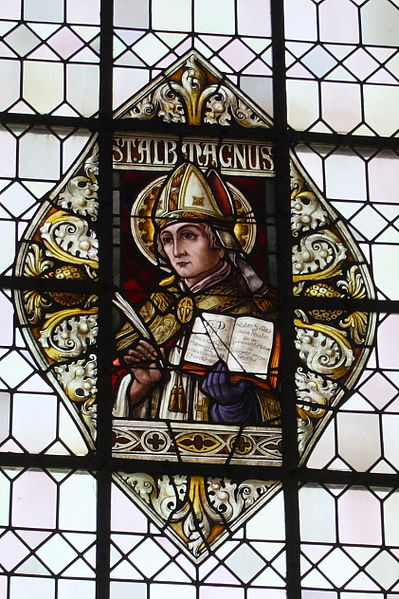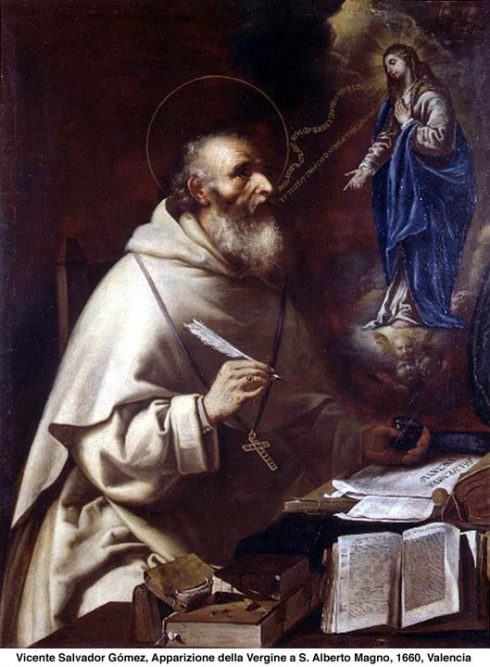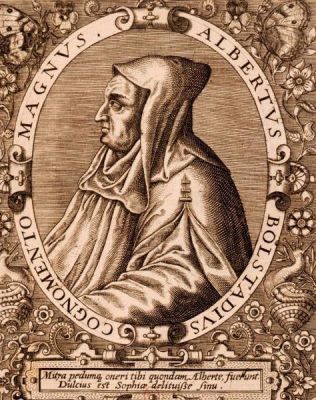St. Albert the Great
Known as Albert the Great; scientist, philosopher, and theologian, born c. 1206; died at Cologne, 15 November 1280. He is called “the Great”, and “Doctor Universalis” (Universal Doctor), in recognition of his extraordinary genius and extensive knowledge, for he was proficient in every branch of learning cultivated in his day, and surpassed all his contemporaries, except perhaps Roger Bacon (1214-94), in the knowledge of nature. Ulrich Engelbert, a contemporary, calls him the wonder and the miracle of his age: “Vir in omni scientia adeo divinus, ut nostri temporis stupor et miraculum congrue vocari possit” (De summo bono, tr. III, iv).
- I. LIFE
Albert, eldest son of the Count of Bollstädt, was born at Lauingen, Swabia, in the year 1205 or 1206, though many historians give it as 1193. Nothing certain is known of his primary or preparatory education, which was received either under the paternal roof or in a school of the neighbourhood. As a youth he was sent to pursue his studies at the University of Padua; that city being chosen either because his uncle resided there, or because Padua was famous for its culture of the liberal arts, for which the young Swabian had a special predilection. The date of this journey to Padua cannot be accurately determined. In the year 1223 he joined the Order of St. Dominic, being attracted by the preaching of Blessed Jordan of Saxony second Master General of the Order. Historians do not tell us whether Albert’s studies were continued at Padua, Bologna, Paris, or Cologne. After completing his studies he taught theology at Hildesheim, Freiburg (Breisgau), Ratisbon, Strasburg, and Cologne. He was in the convent of Cologne, interpreting Peter Lombard’s “Book of the Sentences”, when, in 1245, he was ordered to repair to Paris. There he received the Doctor’s degree in the university which, above all others, was celebrated as a school of theology. It was during this period of reaching at Cologne and Paris that he counted amongst his hearers St. Thomas Aquinas, then a silent, thoughtful youth, whose genius he recognized and whose future greatness he foretold. The disciple accompanied his master to Paris in 1245, and returned with him, in 1248, to the new Studium Generale of Cologne, in which Albert was appointed Regent, whilst Thomas became second professor and Magister Studentium (Master of Students). In 1254 Albert was elected Provincial of his Order in Germany. He journeyed to Rome in 1256, to defend the Mendicant Orders against the attacks of William of St. Amour, whose book, “De novissimis temporum periculis”, was condemned by Pope Alexander IV, on 5 October, 1256. During his sojourn in Rome Albert filled the office of Master of the Sacred Palace (instituted in the time of St. Dominic), and preached on the Gospel of St. John and the Canonical Epistles. He resigned the office of Provincial in 1257 in order to devote himself to study and to teaching. At the General Chapter of the Dominicans held at Valenciennes in 1250, with St. Thomas Aquinas and Peter of Tarentasia (afterwards Pope Innocent V), he drew up rules for the direction of studies, and for determining the system of graduation, in the Order. In the year 1260 he was appointed Bishop of Ratisbon. Humbert de Romanis, Master General of the Dominicans, being loath to lose the services of the great Master, endeavoured to prevent the nomination, but was unsuccessful. Albert governed the diocese until 1262, when, upon the acceptance of his resignation, he voluntarily resumed the duties of a professor in the Studium at Cologne. In the year 1270 he sent a memoir to Paris to aid St. Thomas in combating Siger de Brabant and the Averroists. This was his second special treatise against the Arabian commentator, the first having been written in 1256, under the title “De Unitate Intellectus Contra Averroem”. He was called by Pope Gregory X to attend the Council of Lyons (1274) in the deliberations of which he took an active part. The announcement of the death of St. Thomas at Fossa Nuova, as he was proceeding to the Council, was a heavy blow to Albert, and he declared that “The Light of the Church” had been extinguished. It was but natural that he should have grown to love his distinguished, saintly pupil, and it is said that ever afterwards he could not restrain his tears whenever the name of St. Thomas was mentioned. Something of his old vigour and spirit returned in 1277 when it was announced that Stephen Tempier and others wished to condemn the writings of St. Thomas, on the plea that they were too favourable to the unbelieving philosophers, and he journeyed to Paris to defend the memory of his disciple. Some time after 1278 (in which year he drew up his testament) he suffered a lapse of memory; his strong mind gradually became clouded; his body, weakened by vigils, austerities, and manifold labours, sank under the weight of years. He was beatified by Pope Gregory XV in 1622; his feast is celebrated on the 15th of November. The Bishops of Germany, assembled at Fulda in September, 1872, sent to the Holy See a petition for his canonization; he was finally canonized in 1931.
- II. WORKS
Two editions of Albert’s complete works (Opera Omnia) have been published; one at Lyons in 1651, in twenty-one folio volumes, edited by Father Peter Jammy, O.P., the other at Paris (Louis Vivès), 1890-99, in thirty-eight quarto volumes, published under the direction of the Abbé Auguste Borgnet, of the diocese of Reims. Paul von Loë gives the chronology of Albert’s writings the “Analecta Bollandiada” (De Vita et scriptis B. Alb. Mag., XIX, XX, and XXI). The logical order is given by P. Mandonnet, O.P., in Vacant’s “Dictionnaire de théologie catholique“. The following list indicates the subjects of the various treatises, the numbers referring to the volumes of Borgnet’s edition. Logic: seven treatises (I. 2). Physical Sciences: “Physicorum” (3); “De Coelo et Mundo”, “De Generatione et Corruptione”. “Meteororum” (4); “Mineralium” (5); “De Natura locorum”, ” De passionibus aeris” (9). Biological: “De vegetabilibus et plantis” (10) ” De animalibus” (11-12); “De motibus animalium”, “De nutrimento et nutribili”, “De aetate”, “De morte et vita”, “De spiritu et respiratione” (9). Psychological: “De Anima” (5); “De sensu et sensato”, “De Memoria, et reminiscentia”, “De somno et vigilia”, “De natura et origine animae”, “De intellectu et intelligibili”, “De unitate intellectus” (9). The foregoing subjects, with the exception of Logic, are treated compendiously in the “Philosophia pauperum” (5). Moral and Political: “Ethicorum” (7); “Politocorum (8). Metaphysical: “Metaphysicorum” (6); “De causis et processu universitatis” (10). Theological: “Commentary on the works of Denis the Aereopagite” (14); “Commentary on the Sentences of the Lombard” (25-30); “Summa Theologiae” (31-33); “Summa de creaturis” (34-35); “De sacramento Eucharistiae” (38); “Super evangelium missus est” (37). Exegetical: “Commentaries on the Psalms and Prophets” (15-19); “Commentaries on the Gospels” (20-24); “On the Apocalypse” (38). Sermons (13). The “Quindecim problemata contra Averroistas” was edited by Mandonnet in his “Siger de Brabant” (Freiburg, 1899). The authenticity of the following works is not established: “De apprehensione” (5); “Speculum astronomicum” (5); “De alchimia” (38); Scriptum super arborem Aristotelis” (38); “Paradisus animae” (37); “Liber de Adhaerendo Deo” (37); “De Laudibus B. Virginis” (36); “Biblia Mariana” (37).
- III. INFLUENCE
The influence exerted by Albert on the scholars of his own day and on those of subsequent ages was naturally great. His fame is due in part to the fact that he was the forerunner, the guide and master of St. Thomas Aquinas, but he was great in his own name, his claim to distinction being recognized by his contemporaries and by posterity. It is remarkable that this friar of the Middle Ages, in the midst of his many duties as a religious, as provincial of his order, as bishop and papal legate, as preacher of a crusade, and while making many laborious journeys from Cologne to Paris and Rome, and frequent excursions into different parts of Germany, should have been able to compose a veritable encyclopedia, containing scientific treatises on almost every subject, and displaying an insight into nature and a knowledge of theology which surprised his contemporaries and still excites the admiration of learned men in our own times. He was, in truth, a Doctor Universalis. Of him it in justly be said: Nil tetigit quod non ornavit; and there is no exaggeration in the praises of the modern critic who wrote: “Whether we consider him as a theologian or as a philosopher, Albert was undoubtedly one of the most extraordinary men of his age; I might say, one of the most wonderful men of genius who appeared in past times” (Jourdain, Recherches Critiques). Philosophy, in the days of Albert, was a general science embracing everything that could be known by the natural powers of the mind; physics, mathematics, and metaphysics. In his writings we do not, it is true, find the distinction between the sciences and philosophy which recent usage makes. It will, however, be convenient to consider his skill in the experimental sciences, his influence on scholastic philosophy, his theology.
- IV. ALBERT AND THE EXPERIMENTAL SCIENCES
It is not surprising that Albert should have drawn upon the sources of information which his time afforded, and especially upon the scientific writings of Aristotle. Yet he says: “The aim of natural science is not simply to accept the statements [narrata] of others, but to investigate the causes that are at work in nature” (De Miner., lib. II, tr. ii, i). In his treatise on plants he lays down the principle: Experimentum solum certificat in talibus (Experiment is the only safe guide in such investigations). (De Veg., VI, tr. ii, i). Deeply versed as he was in theology, he declares: “In studying nature we have not to inquire how God the Creator may, as He freely wills, use His creatures to work miracles and thereby show forth His power: we have rather to inquire what Nature with its immanent causes can naturally bring to pass” (De Coelo et Mundo, I, tr. iv, x). And though, in questions of natural science, he would prefer Aristotle to St. Augustine (In 2, Sent. dist. 13, C art. 2), he does not hesitate to criticize the Greek philosopher. “Whoever believes that Aristotle was a god, must also believe that he never erred. But if one believe that Aristotle was a man, then doubtless he was liable to error just as we are.” (Physic. lib. VIII, tr. 1, xiv). In fact Albert devotes a lengthy chapter to what he calls “the errors of Aristotle” (Sum. Theol. P. II, tr. i, quaest. iv). In a word, his appreciation of Aristotle is critical. He deserves credit not only for bringing the scientific teaching of the Stagirite to the attention of medieval scholars, but also for indicating the method and the spirit in which that teaching was to be received. Like his contemporary, Roger Bacon (1214-94), Albert was an indefatigable student of nature, and applied himself energetically to the experimental sciences with such remarkable success that he has been accused of neglecting the sacred sciences (Henry of Ghent, De scriptoribus ecclesiasticis, II, x).
Indeed, many legends have been circulated which attribute to him the power of a magician or sorcerer. Dr. Sighart (Albertus Magnus) examined these legends, and endeavoured to sift the truth from false or exaggerated stories. Other biographers content themselves with noting the fact that Albert’s proficiency in the physical sciences was the foundation on which the fables were constructed. The truth lies between the two extremes. Albert was assiduous in cultivating the natural sciences; he was an authority on physics, geography, astronomy, mineralogy, chemistry (alchimia), zoölogy, physiology, and even phrenology. On all these subjects his erudition was vast, and many of his observations are of permanent value. Humboldt pays a high tribute to his knowledge of physical geography (Cosmos, II, vi). Meyer writes (Gesch. der Botanik): “No botanist who lived before Albert can be compared with him, unless it be Theophrastus, with whom he was not acquainted; and after him none has painted nature in such living colours, or studied it so profoundly, until the time of Conrad, Gesner, and Cesalpini. All honour, then, to the man who made such astonishing progress in the science of nature as to find no one, I will not say to surpass, but even to equal him for the space of three centuries.” The list of his published works is sufficient vindication from the charge of neglecting theology and the Sacred Scriptures. On the other hand, he expressed contempt for everything that savoured of enchantment or the art of magic: “Non approbo dictum Avicennae et Algazel de fascinatione, quia credo quod non nocet fascinatio, nec nocere potest ars magica, nec facit aliquid ex his quae timentur de talibus” (See Quétif, I, 167). That he did not admit the possibility of making gold by alchemy or the use of the philosopher’s stone, is evident from his own words: “Art alone cannot produce a substantial form”. (Non est probatum hoc quod educitur de plumbo esse aurum, eo quod sola ars non potest dare formam substantialem — De Mineral., lib. II, dist. 3).
Roger Bacon and Albert proved to the world that the Church is not opposed to the study of nature, that faith and science may go hand in hand; their lives and their writings emphasize the importance of experiment and investigation. Bacon was indefatigable and bold in investigating; at times, too, his criticism was sharp. But of Albert he said: “Studiosissimus erat, et vidit infinita, et habuit expensum, et ideo multa potuit colligere in pelago auctorum infinito” (Opera, ed. Brewer, 327). Albert respected authority and traditions, was prudent in proposing the results of his investigations, and hence “contributed far more than Bacon did to the advancement of science in the thirteenth century” (Turner, Hist. of Phil.). His method of treating the sciences was historical and critical. He gathered into one vast encyclopedia all that was known in his day, and then expressed his own opinions, principally in the form of commentaries on the works of Aristotle. Sometimes, however, he hesitates, and does not express his own opinion, probably because he feared that his theories, which were “advanced” for those times, would excite surprise and occasion unfavourable comment. “Dicta peripateticorum, prout melius potui exposui: nec aliquis in eo potest deprehendere quid ego ipse sentiam in philosophia naturali” (De Animalibus, circa finem). In Augusta Theodosia Drane’s excellent work on “Christian Schools and Scholars” (419 sqq.) there are some interesting remarks on “a few scientific views of Albert, which show how much he owed to his own sagacious observation of natural phenomena, and how far he was in advance of his age. . . .” In speaking of the British Isles, he alluded to the commonly received idea that another Island — Tile, or Thule — existed in the Western Ocean, uninhabitable by reason of its frightful clime, “but which”, he says, has perhaps not yet been visited by man”. Albert gives an elaborate demonstration of the sphericity of the earth; and it has been pointed out that his views on this subject led eventually to the discovery of America (cf. Mandonnet, in “Revue Thomiste”, I, 1893; 46-64, 200-221).
- V. ALBERT AND SCHOLASTIC PHILOSOPHY
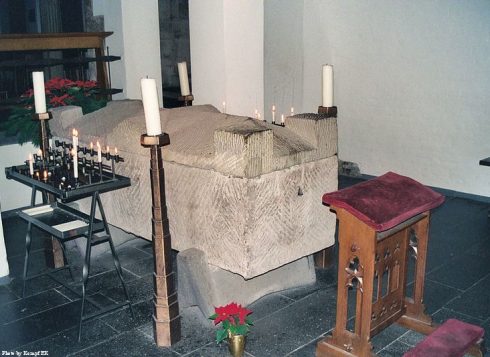
Roman sarcophagus containing the relics of St. Albert in the crypt of St. Andreas church in Cologne, Germany
More important than Albert’s development of the physical sciences was his influence on the study of philosophy and theology. He, more than any one of the great scholastics preceding St. Thomas, gave to Christian philosophy and theology the form and method which, substantially, they retain to this day. In this respect he was the forerunner and master of St. Thomas, who excelled him, however, in many qualities required in a perfect Christian Doctor. In marking out the course which other followed, Albert shared the glory of being a pioneer with Alexander of Hales (d. 1245), whose “Summa Theologiae” was the first written after all the works of Aristotle had become generally known at Paris. Their application of Aristotelean methods and principles to the study of revealed doctrine gave to the world the scholastic system which embodies the reconciliation of reason and Orthodox faith. After the unorthodox Averroes, Albert was the chief commentator on the works of, Aristotle, whose writings he studied most assiduously, and whose principles he adopted, in order to systematize theology, by which was meant a scientific exposition and defence of Christian doctrine. The choice of Aristotle as a master excited strong opposition. Jewish and Arabic commentaries on the works of the Stagirite had given rise to so many errors in the eleventh, twelfth and thirteenth centuries that for several years (1210-25) the study of Aristotle’s Physics and Metaphysics was forbidden at Paris. Albert, however, knew that Averroes, Abelard, Amalric, and others had drawn false doctrines from the writings of the Philosopher; he knew, moreover, that it would have been impossible to stem the tide of enthusiasm in favour of philosophical studies; and so he resolved to purify the works of Aristotle from Rationalism, Averroism, Pantheism, and other errors, and thus compel pagan philosophy to do service in the cause of revealed truth. In this he followed the canon laid down by St. Augustine (II De Doct. Christ., xl), who declared that truths found in the writings of pagan philosophers were to be adopted by the defenders of the true faith, while their erroneous opinions were to be abandoned, or explained in a Christian sense. (See St. Thomas, Summa Theol., I, Q. lxxxiv, a. 5.)  All inferior (natural) sciences should be the servants (ancillae) of Theology, which is the superior and the mistress (ibid., 1 P., tr. 1, quaest. 6). Against the rationalism of Abelard and his followers Albert pointed out the distinction between truths naturally knowable and mysteries (e.g. the Trinity and the Incarnation) which cannot known without revelation (ibid., 1 P., tr. III, quaest. 13). We have seen that he wrote two treatises against Averroism, which destroyed individual immortality and individual responsibility, by teaching that there is but one rational soul for all men. Pantheism was refuted along with Averroism when the true doctrine on Universals, the system known as moderate Realism, was accepted by the scholastic philosophers. This doctrine Albert based upon the Distinction of the universal ante rem (an idea or archetype in the mind of God), in re (existing or capable of existing in many individuals), and post rem (as a concept abstracted by the mind, and compared with the individuals of which it can be predicated). “Universale duobus constituitur, natura, scilicet cui accidit universalitas, et respectu ad multa. qui complet illam in natura universalis” (Met., lib. V, tr. vi, cc. v, vi). A.T. Drane (Mother Raphael, O.S.D.) gives a remarkable explanation of these doctrines (op. cit. 344-429). Though follower of Aristotle, Albert did not neglect Plato. “Scias quod non perficitur homo in philosophia, nisi scientia duarum philosophiarum, Aristotelis et Platonis (Met., lib. I, tr. v, c. xv). It is erroneous to say that he was merely the “Ape” (simius) of Aristotle. In the knowledge of Divine things faith precedes the understanding of Divine truth, authority precedes reason (I Sent., dist. II, a. 10); but in matters that can be naturally known a philosopher should not hold an opinion which he is not prepared to defend by reason ibid., XII; Periherm., 1, I, tr. l, c. i). Logic, according to Albert, was a preparation for philosophy teaching how we should use reason in order to pass from the known to the unknown: “Docens qualiter et per quae devenitur per notum ad ignoti notitiam” (De praedicabilibus, tr. I, c. iv). Philosophy is either contemplative or practical. Contemplative philosophy embraces physics, mathematics, and metaphysics; practical (moral) plilosophy is monastic (for the individual), domestic (for the family), or political (for the state, or society). Excluding physics, now a special study, authors in our times still retain the old scholastic division of philosophy into logic, metaphysics (general and special), and ethics.
All inferior (natural) sciences should be the servants (ancillae) of Theology, which is the superior and the mistress (ibid., 1 P., tr. 1, quaest. 6). Against the rationalism of Abelard and his followers Albert pointed out the distinction between truths naturally knowable and mysteries (e.g. the Trinity and the Incarnation) which cannot known without revelation (ibid., 1 P., tr. III, quaest. 13). We have seen that he wrote two treatises against Averroism, which destroyed individual immortality and individual responsibility, by teaching that there is but one rational soul for all men. Pantheism was refuted along with Averroism when the true doctrine on Universals, the system known as moderate Realism, was accepted by the scholastic philosophers. This doctrine Albert based upon the Distinction of the universal ante rem (an idea or archetype in the mind of God), in re (existing or capable of existing in many individuals), and post rem (as a concept abstracted by the mind, and compared with the individuals of which it can be predicated). “Universale duobus constituitur, natura, scilicet cui accidit universalitas, et respectu ad multa. qui complet illam in natura universalis” (Met., lib. V, tr. vi, cc. v, vi). A.T. Drane (Mother Raphael, O.S.D.) gives a remarkable explanation of these doctrines (op. cit. 344-429). Though follower of Aristotle, Albert did not neglect Plato. “Scias quod non perficitur homo in philosophia, nisi scientia duarum philosophiarum, Aristotelis et Platonis (Met., lib. I, tr. v, c. xv). It is erroneous to say that he was merely the “Ape” (simius) of Aristotle. In the knowledge of Divine things faith precedes the understanding of Divine truth, authority precedes reason (I Sent., dist. II, a. 10); but in matters that can be naturally known a philosopher should not hold an opinion which he is not prepared to defend by reason ibid., XII; Periherm., 1, I, tr. l, c. i). Logic, according to Albert, was a preparation for philosophy teaching how we should use reason in order to pass from the known to the unknown: “Docens qualiter et per quae devenitur per notum ad ignoti notitiam” (De praedicabilibus, tr. I, c. iv). Philosophy is either contemplative or practical. Contemplative philosophy embraces physics, mathematics, and metaphysics; practical (moral) plilosophy is monastic (for the individual), domestic (for the family), or political (for the state, or society). Excluding physics, now a special study, authors in our times still retain the old scholastic division of philosophy into logic, metaphysics (general and special), and ethics.
- VI. ALBERT’S THEOLOGY
In theology Albert occupies a place between Peter Lombard, the Master of the Sentences, and St. Thomas Aquinas. In systematic order, in accuracy and clearness he surpasses the former, but is inferior to his own illustrious disciple. His “Summa Theologiae” marks an advance beyond the custom of his time in the scientific order observed, in the elimination of useless questions, in the limitation of arguments and objections; there still remain, however, many of the impedimenta, hindrances, or stumbling blocks, which St. Thomas considered serious enough to call for a new manual of theology for the use of beginners — ad eruditionem incipientium, as the Angelic Doctor modestly remarks in the prologue of his immortal “Summa”. The mind of the Doctor Universalis was so filled with the knowledge of many things that he could not always adapt his expositions of the truth to the capacity of novices in the science of theology. He trained and directed a pupil who gave the world a concise, clear, and perfect scientific exposition and defence of Christian Doctrine; under God, therefore, we owe to Albertus Magnus the “Summa Theologica” of St. Thomas.
D.J. KENNEDY (Catholic Encyclopedia)
[He was canonized in 1931 by Pope Pius XI]